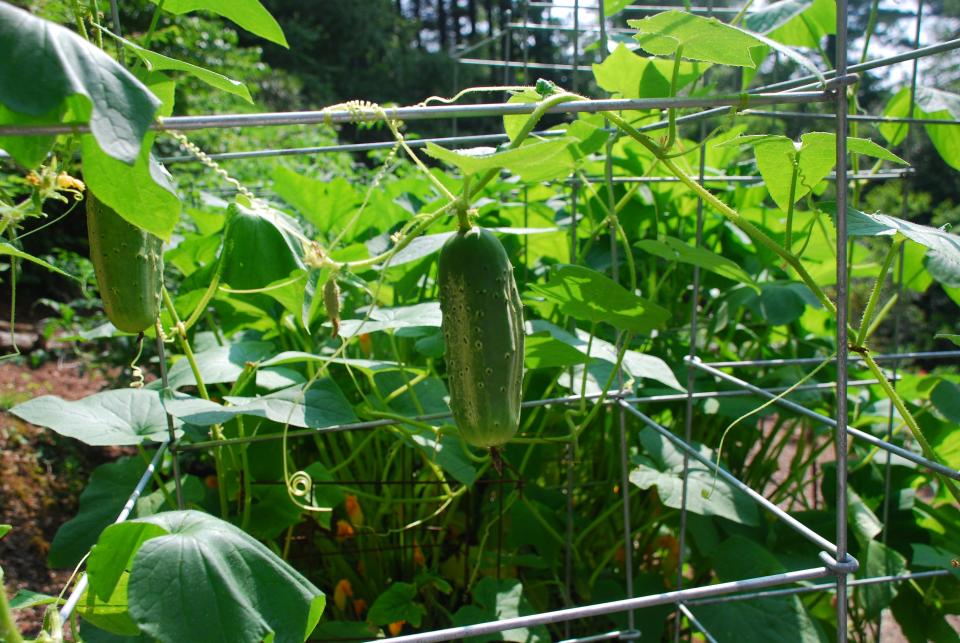Let's plant a vegetable garden
Summer time means delicious vegetables and it is not too late to plant a few vegetable plants for your own enjoyment. There is nothing that taste better than fresh tomatoes that are vine ripe that you have grown. There is a flavor and juiciness that makes your tomatoes taste the best. Plus, you have the pleasure of growing and picking them yourself.
You might say; “I do not have any room.” Well almost everyone has room for a few vegetable plants. As long as you have a place that gets some sun, there are several vegetables that you can add to your landscape without giving up your pretty garden.
You can plant a vining tomato, squash or cucumbers inside a vertical cage and the pretty foliage of any of these plants will be a nice addition to your garden. I have grown squash, cucumber, and tomatoes in cages for years and they are most attractive. Plus, it is fun to pick cucumbers and squash at eye-level instead of on the ground.

Of course, the vegetable that is grown the most is tomatoes and you can put a few plants in a pretty container on your patio or by your front door. You can also go to Lowe’s or the Home Depot and get the supplies to hook up automatic watering system that will keep your plants watered when you are on vacation.
You can purchase plants from a local garden center since it is a little late to grow tomatoes from seed. If you want to start with a few tomato plants, one secret is to plant them right. Plant your plants deeper than they come in the pot. When you plant in this way, the tomato plants will develop roots along the part of the stem that is underground. This additional root system will help support the plant and give it a better root system. (This is true for tomatoes, never try this on trees and shrubs or they will die).
Fertilize with a liquid fertilizer like Miracle Grow when you first plant them, and then after about two weeks give them a handful of triple 17. Put about ¼ cup of Epson salt around the base of each plant. Tomato plants are heavy feeders and the plant is putting out lots of fruit, which requires extra help. (People who plant in sandy soil will need to feed more often since the fertilizer leaches out quicker, and less often in heavy clay soil.) Do not over fertilize at first. You can go back and give them more every 3 to 4 weeks. You do not want to burn them.
The first time I planted tomatoes I planted them in soil where I had mixed in a lot of cotton mote compost. I had the biggest vines you have ever seen. But, I had no tomatoes. The soil was rich for sure, too rich in nitrogen. I am telling you this so you will not make my mistake and have overly rich soil.
Water regularly, especially when you first plant. You can get blossom rot if they do not get regularly water, especially at first. It is hard to be specific on water and it can damage the plant if you try to play catch up when they get too dry. If you have a hot dry spell like we often do in late June, you will need to water more often.
When the plants reach maturity, you might need to slow down just a little on water. Too much water can also cause cracking, when the skin cannot expand quickly to account for the amount of moisture.
You want the ground to dry out some between watering but you do not want the soil to get “bone dry”. That could be fatal. If you have clay soil, it holds more moisture than sandy soil and you might need less water. Make sure you water well each time, making sure the ground gets wet deep down.
You want to keep the leaves on the plant dry if possible. Do not water overhead in the late evening or the water that stays on the leaves all night might encourage disease or fungus.
As the summer progresses, prune your tomatoes. The suckers that develop after the plant is mature are usually weak and they do not produce very large or healthy tomatoes. Remove the suckers to let more sunlight into the plant. The extra foliage can shade out the plant and if you prune off the suckers, more sunlight will get into the mature plant. It will also put more nutrients towards the stems that are growing the tomatoes.
It is not mandatory but you can remove the bottom leaves of the plants. This will help you have better air circulation and these lower leaves could become diseased. They are the first to turn yellow.
Now, there are two kinds of tomatoes. There are the bush tomatoes (determinate) and the vine tomatoes (indeterminate). The bush tomatoes grow to a certain height and produce fruit during a shorter period of time. This helps the commercial growers harvesting the tomatoes over a shorter time frame. Vining tomatoes (indeterminate) produce fewer tomatoes at one time but they produce over a longer period of time, usually producing until frost. They are a vine tomato and need taller support. These tomatoes need fertilizer until they stop producing tomatoes in the fall. Heirloom tomatoes are vining tomatoes.
You know your tomatoes are ripe when they turn a uniform color, red, yellow, pink or dark purple, depending on the variety you have planted. There are many different varieties of tomatoes, too many for mention here.
My personal favorite are Cherokee Purple and the tiny Tommy Toes heirloom tomatoes are the sweetest ones I have ever eaten. Our grandchildren will even eat them because they are very sweet.
Have fun growing some vegetables and Happy Gardening! Betty Montgomery is a master gardener and author of “Hydrangeas: How To Grow, Cultivate & Enjoy,” and “A Four-Season Southern Garden.” She can be reached at bmontgomery40@gmail.com.

This article originally appeared on The Fayetteville Observer: How to grow vegetables and advice on growing perfect tomatoes.

